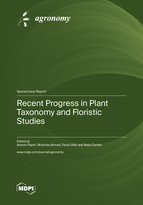Recent Progress in Plant Taxonomy and Floristic Studies
A special issue of Agronomy (ISSN 2073-4395). This special issue belongs to the section "Horticultural and Floricultural Crops".
Deadline for manuscript submissions: closed (30 April 2023) | Viewed by 32607
Special Issue Editors
Interests: plant cell biology; autophagy; programmed cell death; plant anatomy
Special Issues, Collections and Topics in MDPI journals
Interests: plant systematics and biodiversity; medicinal plants and nanotechnology; nutraceuticals and pharmaceutics products; applied palynology
Interests: plant populations; taxonomy; systematics; ecology; genes
Special Issues, Collections and Topics in MDPI journals
Special Issue Information
Dear Colleagues,
There is a relentless human need to understand life through tracing the historical development of the discipline of plant sciences, the part of natural science that covers traditionally treated plants.
The history of plant taxonomy and floristic studies, the botanical classification of plants into different groups and their distribution in different natural habitats and evolution, stretches from the work of ancient Greek to modern evolutionary botanists and plant scientists. As an area of science, plant systematics came into being slowly, early plant usually being considered as part of the research of medicine or drugs. Later on, classification, description and evolution were driven through natural biology and natural history. Until the discovery of the theory of evolution, almost all classifications and descriptions were based on natural history and natural biology. Botany in the 18th and 19th centuries made significant advancements toward more holistic classification methodology, eventually based on evolutionary relationships.
The aim and scope of the Special Issue cover scientific articles from different areas of systematics and taxonomy, including classical taxonomy- and modern phylogenetics-based progress in the field. This also covers biodiversity and evolution, and floristics studies from different geographical areas. Papers in any of the following and related fields will be considered for this Special Issue:
The journal Agronomy runs a Special Issue on taxonomy to invite articles on specific topics. The aim is to build a community of researchers, authors and scientific readers to discuss the current research and development, as well as new ideas and research directions in taxonomy and floristic studies. This Special Issue is led by Guest Editors, who have experience in the area and oversee the editorial process for articles. Articles published in this Special Issue will be collected on a dedicated page of the journal website online. For any questions related to this Special Issue, please contact the Editorial Office.
Taxonomy, floristic studies, biosystematics, classical taxonomy, and modern taxonomic advances, phylogenomics, phylogenetics and biogeography, including phylogeography, and the description of well documented new taxonomic taxa, monographs, taxonomic revisions. It incorporates data from classical morphology (including both macro and micro morphology), molecular study, anatomy and ecology, distribution, molecular evolution, evolutionary development, population biology, conservation biology, evolutionary ecology, paleobiology, and related methods and theories in recent development in systematics and floristic studies. This issue invites research articles, review articles, taxonomic revisions, and short communications.
Prof. Dr. Alessio Papini
Prof. Dr. Mushtaq Ahmad
Dr. Fazal Ullah
Dr. Wajid Zaman
Guest Editors
Manuscript Submission Information
Manuscripts should be submitted online at www.mdpi.com by registering and logging in to this website. Once you are registered, click here to go to the submission form. Manuscripts can be submitted until the deadline. All submissions that pass pre-check are peer-reviewed. Accepted papers will be published continuously in the journal (as soon as accepted) and will be listed together on the special issue website. Research articles, review articles as well as short communications are invited. For planned papers, a title and short abstract (about 100 words) can be sent to the Editorial Office for announcement on this website.
Submitted manuscripts should not have been published previously, nor be under consideration for publication elsewhere (except conference proceedings papers). All manuscripts are thoroughly refereed through a single-blind peer-review process. A guide for authors and other relevant information for submission of manuscripts is available on the Instructions for Authors page. Agronomy is an international peer-reviewed open access monthly journal published by MDPI.
Please visit the Instructions for Authors page before submitting a manuscript. The Article Processing Charge (APC) for publication in this open access journal is 2600 CHF (Swiss Francs). Submitted papers should be well formatted and use good English. Authors may use MDPI's English editing service prior to publication or during author revisions.
Keywords
- systematics
- taxonomy
- floristic studies
- distribution
- phylogeny









